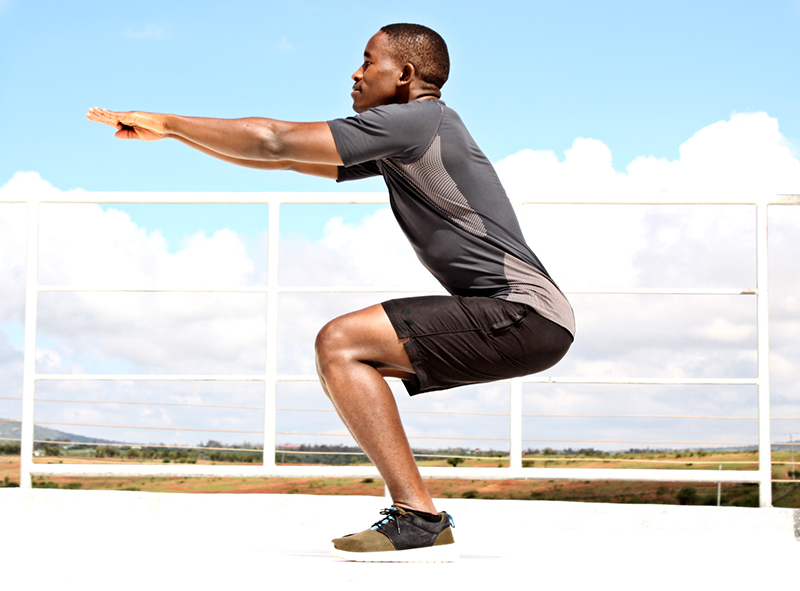The Importance of Strength Training for Beginners

If you’re new to working out, strength training might seem intimidating. However, incorporating strength training into your fitness routine can benefit your health and well-being.
Not only does it help increase muscle mass and bone density, but it can also improve joint stability and balance, reduce the risk of injury, and increase metabolism. Strength training doesn’t mean just lifting heavy weights either.
It can include bodyweight exercises like push-ups or squats, resistance bands, or even household items like water bottles as weights. The key is to challenge yourself with progressively heavier weights over time to see results.
Introducing Power Up: The Beginner’s Strength Training Program
The Power Up program is a beginner-friendly strength training program designed to help you build muscle and increase strength over eight weeks. This program includes exercises that focus on the major muscle groups in the upper body, lower body, and core. One of the key benefits of Power Up is its focus on proper form and technique for each exercise.
The program includes detailed instructions on performing each exercise correctly to avoid injury and get maximum benefit from the movements. Additionally, Power Up offers a progressive overload approach where weight or reps are increased gradually over time as your muscles adapt to the stress being placed on them.
Whether you’re looking to build muscle mass or improve your overall fitness level, Power Up is an excellent place for beginners looking to add strength training into their workout routine. In the following sections, we’ll go over some essential steps needed before starting this program, such as warming up before exercising and stretching correctly in order to prevent injuries during workouts.
Getting Started
Importance of Warming Up Before Exercise

Starting any exercise routine without warming up is like driving a car without warming up the engine. A proper warm-up is essential to prepare your body for physical activity and prevent injury. The benefits of warming up include increasing blood flow to muscles, raising your core temperature, and improving flexibility.
Before starting the Power Up program, doing a 5-10 minute cardio warm-up such as jogging in place or jumping jacks is recommended. This will increase circulation and make your muscles more elastic.
Afterward, you can perform dynamic stretching exercises that mimic movements you will do during the workout. Examples include leg swings, arm circles, and lunges with twists.
How to Properly Stretch to Prevent Injury
Stretching helps increase flexibility and range of motion while also reducing muscle soreness and stiffness after exercising. It’s important to note that not all stretching is equal – there are two main types: dynamic and static.
Dynamic stretching involves active movement through a range of motion, while static stretching requires holding a stretch position for an extended period of time. The former is better suited as part of a warm-up routine, while the latter should be done after exercise when the muscles are already warmed.
When performing dynamic stretches before your Power Up workout, aim for 10-15 reps per stretch on each side of your body. Hold each stretch position for at least 30 seconds on each side for static stretches after exercise.
Recommended Equipment for the Power Up Program
The Power Up program can be done both at home or at a gym, depending on what equipment you have available. Recommended equipment includes dumbbells (5lbs-15lbs), resistance bands with various resistance levels, an exercise mat or towel for comfort while on the floor, and a chair or bench for step-ups and tricep dips. If you don’t have access to equipment, don’t worry!
The Power Up program can be modified to use bodyweight exercises such as push-ups, squats, and lunges. Remember that the key to success is consistency – make sure you have access to adequate equipment and space to perform the routine regularly.
Exercises for Upper Body Strength
Pump Up Your Upper Body
Regarding upper body strength, the Power Up program has several exercises that will help beginners build muscle and tone their arms, chest, and shoulders. The first exercise is push-ups, which are great for developing overall upper-body strength.
To do a push-up, start on your hands and knees with your hands shoulder-width apart. Then lift your knees off the ground and keep your body straight as you lower yourself towards the ground.
Push back up to the starting position. Dumbbell curls are another great exercise for building bicep strength.
To perform this exercise, stand with feet shoulder-width apart and hold a dumbbell in each hand with palms facing forward. Keeping your elbows close to your sides, curl the weight towards your shoulders while exhaling.
Slowly lower the weights back down to starting position while inhaling before repeating the movement. Beginners should start with light weights of around 5-10 pounds on each side and gradually increase as they become stronger.
Shoulder Presses: A Beginner’s Guide
Shoulder presses are also excellent for building upper body strength and toning shoulders muscles. To perform a shoulder press, sit on a bench or chair with feet firmly planted on the ground about hip-width apart. Hold two dumbbells at shoulder height with palms facing forward while keeping elbows bent at 90 degrees angle.
Exhale as you lift both weights above head until arms are fully extended overhead then slowly bring them back down to starting position inhaling. It’s important to remember that when performing any exercise for upper body strength, proper form is crucial in preventing injury as well as maximizing muscle development over time.
Beginners should also start out with light weights before progressing onto heavier weights as they gain more experience in their training program. By following these tips and including these exercises into your Power Up program, you will be on your way to achieving a stronger and more toned upper body.
Exercises for Lower Body Strength
Squats: Building a Strong Foundation
Squats are one of the most effective lower body exercises that you can do to build overall strength and muscle mass. To properly execute a squat, stand with your feet shoulder-width apart, toes pointed slightly outwards.
Keep your chest up and your core engaged throughout the exercise. Slowly lower yourself down by bending at the knees and hips until your thighs are parallel to the floor.
Push back up through your heels, keeping your weight on the balls of your feet. A common mistake when performing squats is not keeping the weight on the heels, which can lead to knee pain or injury over time.
Another mistake is allowing the knees to cave inward during the exercise, which puts unnecessary pressure on them. To avoid these mistakes and progress in weight and reps over time, start with bodyweight squats and focus on perfecting form before adding weights such as dumbbells or barbells.
Lunges: Hitting All The Right Spots
Lunges are another great exercise that targets multiple muscles in the lower body including quadriceps, hamstrings, glutes, and calves. To perform lunges correctly, begin by standing straight with feet hip-distance apart.
Step forward with one foot while lowering down until both legs form a 90-degree angle; make sure your front knee doesn’t extend beyond your toes while lunging down. Push back up through your front heel to return to starting position.
It’s important not to let momentum do any of the work when performing lunges; take controlled steps instead of springing forward or dropping down too quickly. Also make sure that you don’t let one knee travel too far ahead of you than other for better balance and muscle activation throughout all areas targeted during lunges.
Start with bodyweight lunges and increase the reps before progressing to weighted lunges. Over time, you can progressively increase the weight and number of sets for each exercise to maximize your strength and muscle growth.
Core Strength: More Than Just Abs
When most people think of core muscles, they immediately picture six-pack abs. However, the core is actually a complex group of muscles that includes not only the rectus abdominis (the muscle responsible for those coveted abs), but also the obliques, transverse abdominis, and back extensors.
These muscles work together to stabilize your entire body during movement and to protect your spine from injury. The plank is one of the most effective exercises for strengthening all these core muscles.
To perform a plank, start in a push-up position with your hands directly under your shoulders and your feet hip-width apart. Engage your core by drawing your belly button in towards your spine and keeping your back flat.
Hold this position for as long as you can without allowing your hips to sag or raise them up too high. As you progress, you can increase the difficulty by adding arm or leg movements or by holding the plank for longer periods of time.
Sit-Ups: Not Just for Gym Class
Sit-ups are often associated with elementary school gym classes or military training. Still, they are actually a highly effective way to strengthen not only your rectus abdominis but also your hip flexors and lower back muscles. To perform a sit-up, lie on your back with knees bent and feet flat on the floor. Cross your arms over your chest or place them behind your head (but don’t pull on it).
Engage your core by contracting it inwards towards the floor before lifting yourself up with control until you reach an upright seated position engaging abdominal muscles throughout this motion — don’t just use momentum to fling yourself upward! Lower yourself back down slowly and repeat.
Russian twists are another great exercise for targeting obliques while also engaging other core muscles such as rectus abdominis (abs) and transverse abdominis (deep core muscles that help stabilize the spine). To perform a Russian twist, sit on the floor with your knees bent and feet flat on the floor.
Lean back slightly until you feel your abs engage. Pick up light weights or use a medicine ball and hold it in front of your chest with both hands, then twist your torso to one side while lowering the weight towards the ground near your hip.
Return to center and immediately twist to the other side while keeping abs engaged throughout. As you progress, try adding more weight or reps to increase difficulty.
Creating a Routine

When it comes to strength training, consistency is key. To see progress, it’s important to create and stick to a routine. The Power Up program recommends doing each exercise at least twice a week, with at least one day of rest in between each workout.
If you’re short on time, you can split the exercises into upper body one day and lower body the next. It’s also important to consider your individual goals when creating your routine.
Are you looking to build muscle mass? Increase endurance?
Lose weight? Depending on what you’re trying to achieve, you may need to adjust your workout accordingly.
For example, if your goal is muscle growth, you’ll want to focus on doing fewer reps with heavier weights. If you’re looking for endurance, however, you’ll want to do more reps with lighter weights.
Suggestions on How to Structure a Workout Routine Based on Individual Goals
If your goal is muscle growth: – Start with compound exercises like squats and deadlifts that work for multiple muscle groups at once
– Focus on lifting heavier weights for fewer reps (around 6-8) – Do 3-4 sets of each exercise with 1-2 minutes of rest in between
– Incorporate isolation exercises like bicep curls or tricep extensions for additional targeted muscle growth If your goal is endurance:
– Start with cardio exercises like running or cycling – Focus on lifting lighter weights for more reps (around 12-15)
– Do 2-3 sets of each exercise with shorter rest periods in between (30 seconds – 1 minute) – Incorporate circuit training by doing multiple exercises back-to-back without rest
If your goal is weight loss: – Focus on high-intensity interval training (HIIT) workouts that combine cardio and strength training
– Alternate between periods of high-intensity exercise and periods of rest – Incorporate full-body exercises like burpees or jumping jacks to maximize calorie burn
– Aim to do at least 3-4 workouts per week for optimal weight loss results Remember, it’s important to listen to your body and adjust your routine as needed.
If you’re feeling sore or fatigued, take a break and give your muscles time to recover. The Power Up program can help you achieve your strength training goals with dedication and consistency.
Nutrition Tips for Building Muscle
When it comes to building muscle, proper nutrition is just as important as the actual workouts. If you’re not fueling your body with the right nutrients, you may not see the results you want or may even risk injury. Here are some essential tips for eating to build muscle:
Why Nutrition is Important When Strength Training
Strength training breaks down muscle fibers, which then need to be repaired and strengthened through a process called protein synthesis. In order for this process to occur, your body needs an adequate supply of protein and other essential nutrients such as carbohydrates and healthy fats. Protein specifically is crucial because it provides the building blocks (amino acids) that your muscles need in order to recover and grow.
In addition, strength training can increase your metabolism, meaning that you burn more calories even at rest. Therefore, it’s important to fuel your body with nutritious foods so that you have enough energy for both workouts and everyday life.
Suggestions on What Foods to Eat Before and After Workouts
Before a workout: It’s important to eat a meal or snack that provides both carbohydrates (for energy) and protein (for muscle recovery). Ideally, aim to eat this meal 1-2 hours before your workout so that your body has time to digest.
Good options include:
- A smoothie with fruit and Greek yogurt
- A turkey or chicken sandwich on whole grain bread
- Oatmeal with nuts or seeds
- Banana with almond butter
After a workout: Your muscles are craving nutrients after a tough workout! Aim to eat a meal within 30 minutes of finishing your workout that contains carbohydrates (to replenish glycogen stores) and protein (to repair muscle fibers).
Good options include:
- Grilled chicken with sweet potato and veggies
- A protein shake with fruit and almond milk
- Greek yogurt with berries and granola
- Tofu stir-fry with brown rice
Remember, building muscle takes time and consistency. By fueling your body with the right nutrients, you’ll be able to see the results of your hard work in no time!
Conclusion
Congratulations! You have made it to the end of the Power Up: Strength Training Program for Beginners article.
By now, you should understand the importance of strength training and have a solid foundation on how to start building strength in your upper body, lower body, and core. Remember that consistency is key when it comes to seeing results.
It’s important to stick with the program and gradually increase weight and reps over time. Don’t get discouraged if you don’t see immediate changes – building muscle takes time and patience.
In addition to following the Power Up program, remember to take care of your body by warming up properly before each workout and stretching regularly. Pay attention to your nutrition as well – fueling your body with healthy foods will help you build muscle more effectively.
Overall, incorporating strength training into your fitness routine is a great way to improve not only physical appearance but overall health as well. We hope that this article has provided you with valuable information and motivation to start working towards a stronger, healthier you!
